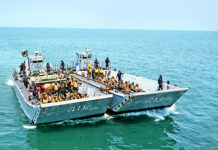

Based on the Introductory Remarks made at Digitisation& Networking in the Armed Forces 2020 Webinar, 23 Nov 2020.
As warfare evolved from the agrarian to the industrial age, we moved from spears to muskets or from bows &arrows to gunpowder. With the industrial age also came the assembly line concept. You take an assembly line – there are workers, there are supervisors, the floor manager and the management above them. Everything was hierarchical, no one could take a decision by himself. No worker can take a decision until the supervisor is involved; the supervisor cannot take a decision until the floor manager is involved, so on and so forth.
The Army in the industrial age took on that hierarchical structure which suited us very well. If you have noticed, when we studied during our younger days our communication lines were also laid up like this – one up, two down – that is what we were taught and that is how it worked in the army. In the industrial age the communication organic. It was on links. In today’s world we have got networks. Now there is a platform. A ship is a platform, an aircraft is a platform, tank is a platform. In each of these platforms, whether ship, tank, aircraft even in a unit, the decision maker, the shooter, the observer, they are all tightly coupled to each other.
ALSO READ: DIGITAL TRANSFORMATION – Challenges of Digital Transformation
Let me explain what I want to say. Let us say the observer sees something, the decision maker is the commander, he orders the gunner to engage so they are tightly coupled to each other but that platform does not task other shooters and that is why I use the word they were tightly coupled to each other. But in the Indian armed forces, the entities have become smart. Why do I use the word smart? A watch is now a smart thing. It is no longer gives you the time, it is doing a whole lot of other functions including sending information back. This is what is leading to a network-centric functions. All entities today are smart and networked where the sensor, shooter, decision maker are now loosely coupled to each other. Loosely coupled can be explained this way. When a sensor got some data of an area, which is not relevant to it, but it publishes the data in a data centre, which may be a central repository somewhere. Someone else can use that data. If we take the Line of Control (LoC) across Kashmir where we have some information, which is in the Haji Pir Bulge, it may have been acquired by a sensor south of PirPanjal but 15 Corps can utilize that information; and if we are networked it may be lying in a repository at the Command HQ. So, anyone who has subscribed for that can pick it up.
Services Networks
For all this network-centric warfare in the armed forces today we have individual communication networks. We have the Army net, we have the Air Force Net (AFNET). We have the Navy Enterprise Wide Network (NEWN) and we also now have the Defence Communications Network (DCN) because we wanted an overarching network where all three Services could be networked together. DCN is a work in progress. The DCN Phase 1 is over. While it is technologically possible, all networks do not really speak to each other the way they should.
There are issues. Security of networks is an issue. The Air Force feels that it is network-centric warfare they have indulged in and they really guard their network security zealously. It is correct and justified but then we have to overcome these issues. There are also hurdles in the social domain. What I would like to bring out is that technologically we can overcome this but we need to get over our tendency to work in silos.
Domains at Work
We work in four layers/domains. The first domain is physical. The second is information domain. Third is the cognitive domain and fourth, social domain. Physical domain is what is deployed on the ground – the gunners, shooters, decision makers. Information domain is where information is passed it is also degrading the info domain of the adversary, war fares are fought in this domain. Cognitive domain is the mind space of the commanders of the participants and the social domain is a network of cognitive domain. In cognitive domain these networks are talking to each other. This is, the commanders may talk to each other at the staff level. There are linkages with each other but in the social domain of these networks we are not able to overcome our reluctance.
Our security concerns and other issues have created barriers. Today, our networks are not talking to each other the way they should.
How do we break these barriers. That is for the technological experts to answer but to ensure that every entity is a smart entity, every entity has to be brought to a network, whether it is a Division or a Corps. We need not only a one-to-one but a larger network of communication. When you are on a network you add value by sharing inputs and there is shared situational awareness.
In a break-out operation, between the break-out and the second obstacle, if everyone has shared situational awareness, everyone can then think of a common operational picture between the shared entities. The moment any entity that is networked, that is smart, has a shared sense of situational awareness, it will be able to pass on the common operational picture. It will become self-synchronized. This lends itself to a directive style of command.



















